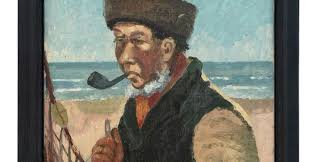
Dream on, starry night. It’s not a Van Gogh.
The painting in question was found at a Minnesota garage sale several years ago. It was purchased and then so to an antiques dealer for less than $50.
“Elimar,” circa 1889, depicts a haggard-looking fisherman with a pipe in his mouth, standing in front of the sea. LMI Group International, a New York-based art-research group, which includes a former curator from the Metropolitan Museum of Art and a team of 20 experts, believes that the painting is a Van Gogh.
It has put $30,000 into trying to prove that.
However, the Van Gogh Museum in Amsterdam has the final say on whether a painting is an authentic Van Gogh. The museum issued the following statement Tuesday to the Minnesota Star Tribune:
“We have considered the new information mentioned in the LMI Group’s ‘Elimar’ report. Based on our previous opinion on the painting in 2019, we maintain our view that this is not an authentic painting by Vincent van Gogh.”
The Van Gogh Museum in Amsterdam was founded by the artist’s nephew in 1973. As it has the largest collection of works by the 19th century post-Impressionist, who died penniless and unknown, its decisions are usually the final word.
According to the New York Times, over the years the museum has been getting more requests to authenticate supposed Van Gogh works of art. In 2021, authentication requests doubled to more than 500. It now handles only about 35 requests per year.
LMI Group International released a 458-page report attempting to prove that this is an authentic Van Gogh.
The report includes scientific analysis showing the egg-white temporary finish and mathematical comparison of the letters “E L I M A R” to other autographed works by Van Gogh.
LMI’s report even includes a “hair partially embedded in the surface of the bottom left corner” that it said DNA analysis verified “belonged to a human male … and that the hair appeared to be red in color.”







